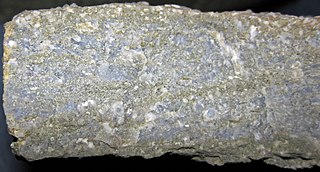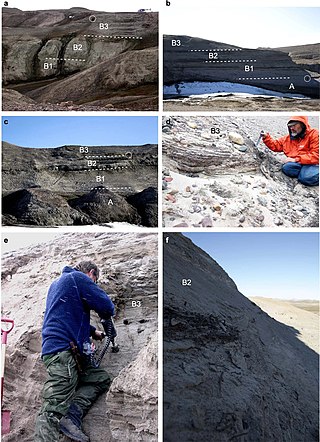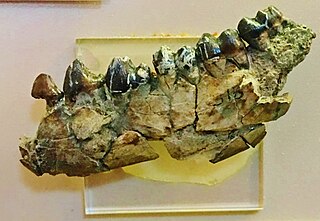
The Fort Payne Formation, or Fort Payne Chert, is a geologic formation found in the southeastern region of the United States. It is a Mississippian Period cherty limestone, that overlies the Chattanooga Shale, and underlies the St. Louis Limestone. To the north, it grades into the siltstone Borden Formation. It preserves fossils dating back to the Carboniferous period.

Ailuravus is a genus of prehistoric rodents in the family Ischyromyidae.
Eocaiman is an extinct genus of caiman containing species living from the Early Paleocene to Miocene in what is now Argentina, Itaboraí Formation of Brazil and Colombia. Eocaiman contains three described species: E. cavernensis, E. palaeocenicus, and E. itaboraiensis, and is typically recovered as one of the more basal members of Caimaninae. Notocaiman was synonymized with Eocaiman paleocenicus in 2022.

Batrachiderpeton is an extinct genus of nectridean tetrapodomorphs within the family Diplocaulidae; it was a basal member of the family. The type species is B. reticulatum and was found in a coal field in Northumberland, England at a locality that also yields the remains of Anthracosaurus russelli. A second species is also known: B. lineatum.
Isodontosaurus is an extinct genus of iguanian lizard from the Late Cretaceous of Mongolia and China. The type species is Isodontosaurus gracilis. Isodontosaurus is part of an extinct group of Late Cretaceous iguanians called Gobiguania, which is currently thought to be endemic to Mongolia.
Perikoala is an extinct genus of marsupials, related to the modern koala. The genus diverged from a common ancestor of the other koala genera Nimiokoala, Litokoala, and Phascolarctos, which contains the living koala.

The Paleobiology Database is an online resource for information on the distribution and classification of fossil animals, plants, and microorganisms.

The Lucas Formation is a geologic formation in Michigan. It preserves fossils dating back to the Devonian period.

The Fairview Formation is a geologic formation in Ohio. It preserves fossils dating back to the Late Ordovician period.
The Fort Atkinson Limestone is a geologic formation in Illinois. It preserves fossils dating back to the Ordovician period.
The Fido Sandstone is a geologic formation in Virginia. It preserves fossils dating back to the Carboniferous period.
The Fern Glen Formation is a geologic formation in eastern and southeastern Missouri. It preserves fossils dating back to the Osagean Series of the Mississippian subperiod.
The Farisita Formation is a geologic formation in Colorado. It preserves fossils dating back to the Paleogene period.

The Kap Kobenhavn Formation is a geologic formation in Greenland. It preserves fossils dating back to the Neogene period.

Tasbacka is an extinct genus of sea turtle containing several species.

Tetraclaenodon was a genus of small and early ungulate mammals that was part of the Phenacodontidae family. It is the oldest and most primitive phenacodontid. Its fossils known from the Nacimiento Formation, New Mexico. In 2012, Tetraclaenodon was defined as the basalmost member of the clade containing "Phenacodontidae" and Altungulata.
The Ferron Point Formation is a geologic formation in Michigan. It preserves fossils dating back to the Devonian period.
Alligator mcgrewi is an extinct species of alligator described by K.P. Schmidt. They lived in the Early Miocene period, and their range was principally in what is now Nebraska, United States.









